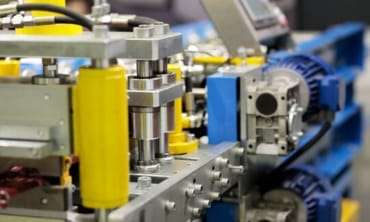Roll forming has become an essential method in manufacturing, especially for industries requiring consistent and intricate metal profiles. This process offers high precision, reduced waste, and a quicker production timeline. However, companies evaluating whether to adopt roll forming often weigh the upfront investment against the long-term benefits. In this article, we’ll dive into the costs and benefits associated with roll forming, offering a clear guide to determining if it’s the right investment for your business.
What Is Roll Forming?
Roll forming is a continuous bending process used to shape long strips of metal into desired profiles. Unlike stamping or extruding, roll forming is ideal for producing long pieces with consistent quality, low waste, and efficient production times.
Key Factors in Roll Forming Investment
To make an informed decision, it’s important to consider the factors contributing to the cost and the corresponding benefits of roll forming. Let’s examine each component in detail.
1. Initial Costs of Roll Forming Equipment
The initial costs of roll forming include the purchase of machinery, setup, and tooling. Here’s a breakdown of these expenses:
- Machinery Investment: Roll forming machines are a long-term investment, ranging from modest prices for basic machines to high-end models for advanced functions.
- Tooling Costs: Custom tooling often represents a significant upfront cost. However, tooling amortization is typically spread over the production volume, reducing per-part cost.
- Installation and Setup: Initial setup costs can be substantial, especially if custom adjustments or additional facility modifications are needed.
2. Reduced Material Waste
One of the major cost-saving advantages of roll forming is the reduction in material waste:
- Precision Forming: Roll forming allows for precision forming, which minimizes offcuts and scraps, optimizing material use.
- Scrap Reduction: Unlike stamping, which can produce significant scrap, roll forming shapes metal efficiently and with minimal waste.
3. High Efficiency and Productivity
Roll forming machines are designed for high throughput, making them ideal for large-scale production runs:
- Faster Production: Once tooling is set, roll forming can produce long profiles quickly and consistently.
- Continuous Process: Roll forming is a continuous operation, reducing downtime and labor costs per part.
- Reduced Labor Costs: The automation of roll forming reduces the need for extensive manual labor, cutting costs and minimizing the risk of human error.
4. Longevity and Durability of Roll Forming Tooling
Unlike other manufacturing methods, roll forming tooling is incredibly durable, often lasting for years:
- Long Tooling Life: Roll form tooling, when maintained, can produce thousands of parts without needing replacement.
- Lower Maintenance Costs: High-quality tooling requires minimal upkeep, lowering maintenance costs over the equipment’s lifespan.
5. Scalability and Customization
Roll forming is scalable and highly customizable, making it ideal for businesses in growing industries such as solar, automotive, and construction:
- Adaptability for Complex Profiles: Roll forming machines can be customized to meet specific design requirements, such as solar strut channels or automotive frames.
- Easy to Scale: For companies looking to expand production, roll forming machines can handle high-volume runs efficiently.
Cost-Benefit Analysis: Weighing Pros and Cons
Benefits of Investing in Roll Forming
- Cost Efficiency: Lower per-unit cost due to high throughput and minimal waste.
- Consistent Quality: Automated precision reduces defect rates and enhances product consistency.
- Longevity of Tooling: Durable tooling lowers the frequency and cost of replacement, maximizing investment value.
- Flexibility for Custom Profiles: Ideal for industries that need custom shapes and profiles.
- Lower Labor Requirements: Automated production minimizes labor costs and decreases error rates.
Potential Drawbacks
- Initial Investment: Roll forming requires a substantial upfront investment for machinery and tooling.
- Long Setup Times: Custom tooling setup may take longer, especially for unique profiles.
- Limited Small-Batch Efficiency: For small runs, roll forming may be less cost-effective compared to other methods.
How to Maximize ROI with Roll Forming
To ensure a worthwhile return on investment, consider the following strategies:
- Amortize Tooling Costs: Spread the tooling investment over high-volume production runs to lower the cost-per-part.
- Regular Maintenance: Implement a routine maintenance schedule to extend the life of roll forming equipment and tooling.
- Optimize Material Use: Work with your supplier to source materials that minimize costs and reduce waste.
- Invest in Operator Training: Skilled operators enhance efficiency, reduce errors, and optimize machine output.
Industries Benefiting Most from Roll Forming
Certain industries benefit more from roll forming due to their need for precision and high-volume production. Key sectors include:
- Solar Industry: Roll forming produces custom strut channels and supports, crucial for solar installations.
- Automotive Manufacturing: Roll forming offers consistent quality for structural components.
- Construction and Infrastructure: Ideal for producing steel beams, channels, and frames with minimal waste.
- Appliances: Appliance manufacturing relies on roll forming for precise metal components.
Is Roll Forming Worth the Investment?
When evaluating the costs and benefits of roll forming, companies should consider production volumes, product consistency, and long-term maintenance costs. Roll forming is a worthwhile investment for industries requiring high-volume production, customization, and precision. While initial costs are higher, the long-term savings from reduced waste, low labor costs, and durability of tooling make roll forming a profitable choice for many manufacturers.
Conclusion
Investing in roll forming offers significant advantages in cost savings, efficiency, and product quality. By weighing the initial costs against these long-term benefits, businesses can determine if roll forming aligns with their production goals and growth strategies. For companies needing high-quality, consistent metal profiles at scale, roll forming often proves to be a valuable and profitable investment.






